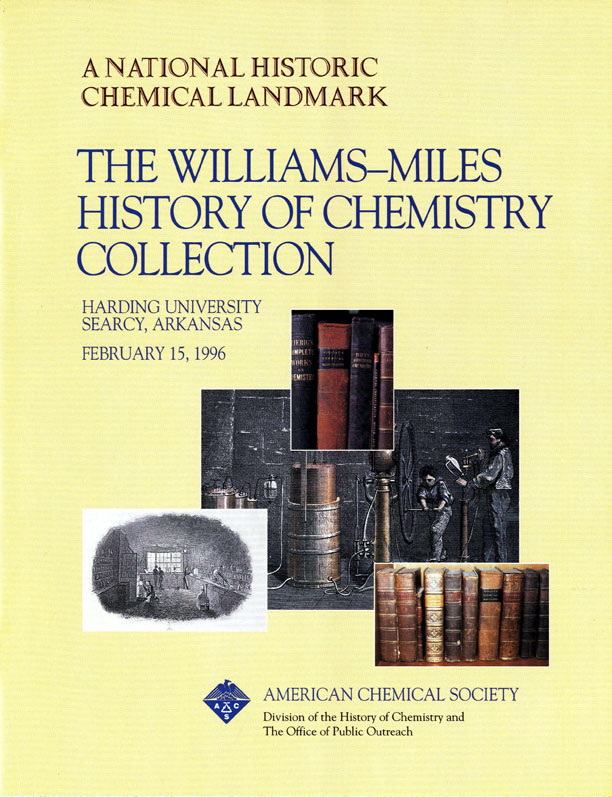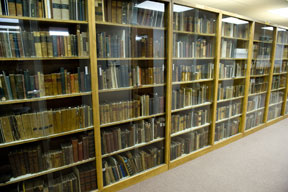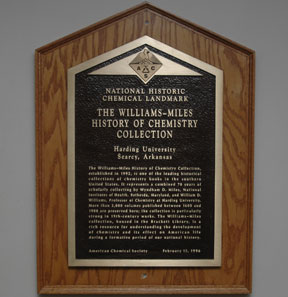Williams-Miles Collection at Harding University
Dedicated February 15, 1996, at Harding University in Searcy, Arkansas.
The Williams-Miles History of Chemistry Collection is an example of a rare collection of books and materials that is essential to researchers in the history of science. In a single location, it preserves more than 2,000 volumes on early chemistry and related sciences. It is particularly rich in 19th-century American works — many in almost all of their variant editions. Although similar collections exist, the Williams-Miles Collection is a significant resource in the southern United States and is located in the Brackett Library at Harding University in Searcy, Arkansas.
Contents
About the Williams-Miles History of Chemistry Collection
The Williams-Miles History of Chemistry Collection was gathered over many years by scholarly searching on limited budgets. The books were purchased, usually one volume at a time, from book dealers all over the United States. The objective was not to acquire rarities, although some are present, but rather to document the progress of chemistry. Emphasis was placed on American chemical imprints published before 1900. Twentieth-century books were not collected systematically, but some unusual works are included. The 2,000 volumes in the collection provide a remarkably complete coverage of 19th-century chemistry.
The collection contains a smaller number of works in other sciences, medicine, and pharmacy, as well as early journals and non-science books by noted chemists. There are unique items associated with early chemists: autographed letters, medals, medallions, bookplates, engravings, and photographs. Also present are postage stamps about chemistry or chemists, advertising trade cards distributed by early chemical firms, some antique laboratory apparatus, and a 1925 children's chemistry set.
Eight books in the collection date from the 1600s, including five by the noted British chemist Robert Boyle. The oldest volume is a 1609 edition of Basilica Chymica by Oswald Croll.
Among the 30 volumes printed in the 1700s are three of the earliest chemistry books published in the United States. Introduction to Natural Philosophy (Philadelphia, 1788) was a textbook of physics and chemistry by the British chemist William Nicholson. It and an earlier British edition were studied in both England and the United States from 1782 to 1805. Chemical and Economic Essays (Philadelphia, 1790) presented aspects of industrial chemistry in early America. It was written by an American, John Penington, who was president of the first chemical society in the United States. A System of Chemistry (Philadelphia, 1791), a separate printing of the "Chemistry" article from the first American edition of the Encyclopedia Britannica, was the first American imprint to introduce the "new chemistry" of Lavoisier.
The collection is particularly rich in 19th-century volumes. Works by prominent foreign chemists are well represented, and there are multiple editions by American and European publishers. For example, the collection contains 15 different American editions of Jane Marcet's Conversations on Chemistry, the most widely used introductory chemistry text in America from 1809 to the 1830s. Some 19th-century books by American chemists are present in almost all of their editions. The collection holds 29 copies of John Comstock's Elements of Chemistry, which was America's most popular chemistry text from 1831 to 1859. Another best-selling chemistry text was Fourteen Weeks in Chemistry, by J. Dorman Steele, which dominated the market from 1868 to 1890. Twenty-five copies of Steele's chemistry text are in the collection.
The collection includes several unique groups of books from the 20th century: 42 volumes for chemistry courses offered by mail from 1900 to 1940 by the International Correspondence Schools of Scranton, Pennsylvania; 20 editions (2nd to 50th, 1914 to 1969) of the widely used reference work, Handbook of Chemistry and Physics; and a diverse selection of books from the early days of radioactivity, including the rare August 1945 Washington, D.C., edition of Henry D. Smyth's history of the Manhattan Project and the development of the atomic bomb.
Some of the books contain inscriptions by the author or signatures or bookplates of noted chemists who once owned them.
The Williams-Miles Collection is located in the Brackett Library at Harding University in Searcy, Arkansas. Volumes are not loaned but are available for on-site research under the usual library regulations for rare books.
Founders of the Williams-Miles History of Chemistry Collection
Wyndham Davies Miles
Miles was educated at the Philadelphia College of Pharmacy and Science, Pennsylvania State University, and Harvard University. After teaching college chemistry and working in industry, he was a science historian for the Army Chemical Corps, the National Archives, the U.S. Navy, and the National Institutes of Health. He edited two volumes of American Chemists and Chemical Engineers, wrote A History of the National Library of Medicine, co-authored The Chemical Warfare Service: From Laboratory to Field, and published more than 100 articles and biographies about the history of chemistry. He served as chairman of the ACS Division of History of Chemistry and received its Dexter Award in the History of Chemistry in 1971. Miles has collected rare chemistry books for 50 years and provided two-thirds of the total volumes in the Williams-Miles Collection.
William Donald Williams
Williams was professor of chemistry at Harding University from 1954 until 1993. He was educated at Harding University and the University of Kentucky.
He worked for six summers in rocket propellant chemistry at Marshall Space Flight Center in Huntsville, Alabama. The author of 25 articles on chemical history, chemical biography, and Arkansas history, he writes the "Old Chemistries" series for the Bulletin for the History of Chemistry. He has been collecting rare chemistry books for nearly 20 years and provided about one-third of the volumes in the Williams-Miles Collection.
Because of their common interests, Miles and Williams became good friends. As they reached retirement age, each donated his collection to Harding University to be preserved for research in historical chemistry. Both men continued to add volumes to the collection after it was established.
Landmark Designation and Acknowledgments
Landmark Designation
The American Chemical Society designated the Williams-Miles History of Chemistry Collection at Harding University as a National Historic Chemical Landmark in a ceremony on February 15, 1996. The plaque commemorating the event reads:
The Williams-Miles History of Chemistry Collection, established in 1992, is one of the leading historical collections of chemistry books in the southern United States. It represents a combined 70 years of scholarly collecting by Wyndham D. Miles, National Institutes of Health, Bethesda, Maryland, and William D. Williams, Professor of Chemistry at Harding University. More than 2,000 volumes published between 1600 and 1900 are preserved here; the collection is particularly strong in 19th-century works. The Williams-Miles Collection, housed in the Brackett Library, is a rich resource for understanding the development of chemistry and its effect on American life during a formative period of our national history.
Acknowledgments
Adapted for the internet from “The Williams-Miles History of Chemistry Collection,” produced by the National Historic Chemical Landmarks program of the American Chemical Society in 1996.
Learn more: About the Landmarks Program
Take action: Nominate a Landmark and Contact the NHCL Coordinator




